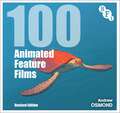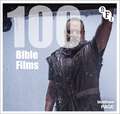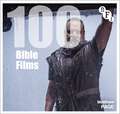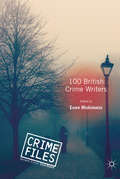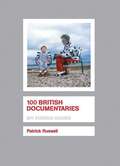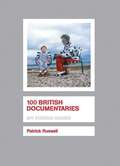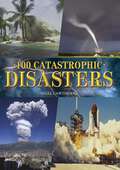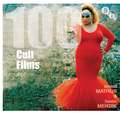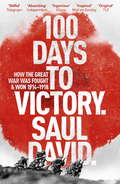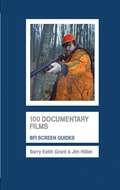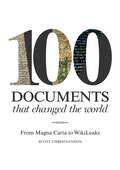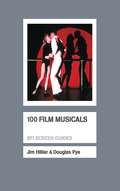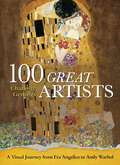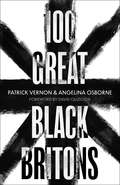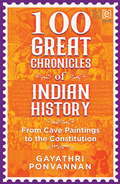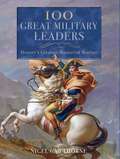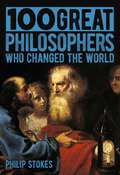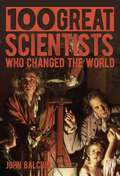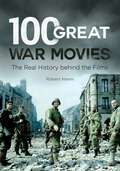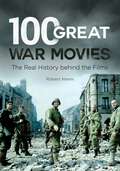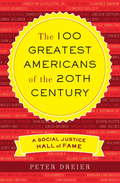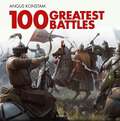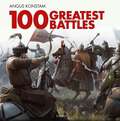- Table View
- List View
100 Animated Feature Films: Revised Edition (BFI Screen Guides)
by Andrew Osmond20 years ago, animated features were widely perceived as cartoons for children. Today, though, they encompass an astonishing range of films, styles and techniques. There is the powerful adult drama of Waltz with Bashir; the Gallic sophistication of Belleville Rendez-Vous; the eye-popping violence of Japan's Akira; and the stop-motion whimsy of Wallace & Gromit in The Curse of the Were-Rabbit. Andrew Osmond provides an entertaining and illuminating guide to the endlessly diverse world of animated features, with entries on 100 of the most interesting and important animated films from around the world, from the 1920s to the present day.Blending in-depth history and criticism, 100 Animated Feature Films balances the blockbusters with local success stories from Eastern Europe to Hong Kong. This revised and updated new edition addresses films that have been released since publication of the first edition, such as the mainstream hits Frozen, The Lego Movie and Spider-Man: Into the Spider Verse, as well as updated entries on franchises such as the Toy Story movies. It also covers bittersweet indy visions such as Don Hertzfeldt's It's Such a Beautiful Day, Charlie Kaufman's Anomalisa, Isao Takahata's Tale of the Princess Kaguya, the family saga The Wolf Children and the popular blockbuster Your Name. Osmond's wide-ranging selection also takes in the Irish fantasy Song of the Sea, France's I Lost My Body and Spain's Chico & Rita. Osmond's authoritative and entertaining entries combine with a contextualising introduction and key filmographic information to provide an essential guide to animated film.
100 Animated Feature Films: Revised Edition (BFI Screen Guides)
by Andrew Osmond20 years ago, animated features were widely perceived as cartoons for children. Today, though, they encompass an astonishing range of films, styles and techniques. There is the powerful adult drama of Waltz with Bashir; the Gallic sophistication of Belleville Rendez-Vous; the eye-popping violence of Japan's Akira; and the stop-motion whimsy of Wallace & Gromit in The Curse of the Were-Rabbit. Andrew Osmond provides an entertaining and illuminating guide to the endlessly diverse world of animated features, with entries on 100 of the most interesting and important animated films from around the world, from the 1920s to the present day.Blending in-depth history and criticism, 100 Animated Feature Films balances the blockbusters with local success stories from Eastern Europe to Hong Kong. This revised and updated new edition addresses films that have been released since publication of the first edition, such as the mainstream hits Frozen, The Lego Movie and Spider-Man: Into the Spider Verse, as well as updated entries on franchises such as the Toy Story movies. It also covers bittersweet indy visions such as Don Hertzfeldt's It's Such a Beautiful Day, Charlie Kaufman's Anomalisa, Isao Takahata's Tale of the Princess Kaguya, the family saga The Wolf Children and the popular blockbuster Your Name. Osmond's wide-ranging selection also takes in the Irish fantasy Song of the Sea, France's I Lost My Body and Spain's Chico & Rita. Osmond's authoritative and entertaining entries combine with a contextualising introduction and key filmographic information to provide an essential guide to animated film.
100 Bible Films (BFI Screen Guides)
by Matthew PageFrom The Passion of the Christ to Life of Brian, and from The Ten Commandments to Last Temptation of Christ, filmmakers have been adapting the stories of the Bible for over 120 years, from first time the Höritz Passion Play was filmed in the Czech Republic back in 1897. Ever since, these stories have inspired musicals, comedies, sci-fi, surrealist visions and the avant garde not to mention spawning their own genre, the biblical epic. Filmmakers across six continents and from all kinds of religious perspectives (or none at all), have adapted the greatest stories ever told, delighting some and infuriating others.100 Bible Films is the indispensible guide to this wide and varied output, providing an authoritative but accessible history of biblical adaptations through one hundred of the most interesting and significant biblical films. Richly illustrated with film stills, this book depicts how such films have undertaken a complex negotiation between art, commerce, entertainment and religion.Matthew Page traces the screen history of the biblical stories from the very earliest silent passion plays, via the golden ages of the biblical epic, through to more innovative and controversial later films as well as covering significant TV adaptations. He discusses films made not only by some of our greatest filmmakers, artists such as Martin Scorsese, Jean Luc Godard, Alice Guy, Roberto Rossellini, Pier Paolo Pasolini, Lotte Reiniger, Carl Dreyer and Luis Buñuel, but also those looking to explore their faith or share it with lovers of cinema the world over.
100 Bible Films (BFI Screen Guides)
by Matthew PageFrom The Passion of the Christ to Life of Brian, and from The Ten Commandments to Last Temptation of Christ, filmmakers have been adapting the stories of the Bible for over 120 years, from first time the Höritz Passion Play was filmed in the Czech Republic back in 1897. Ever since, these stories have inspired musicals, comedies, sci-fi, surrealist visions and the avant garde not to mention spawning their own genre, the biblical epic. Filmmakers across six continents and from all kinds of religious perspectives (or none at all), have adapted the greatest stories ever told, delighting some and infuriating others.100 Bible Films is the indispensible guide to this wide and varied output, providing an authoritative but accessible history of biblical adaptations through one hundred of the most interesting and significant biblical films. Richly illustrated with film stills, this book depicts how such films have undertaken a complex negotiation between art, commerce, entertainment and religion.Matthew Page traces the screen history of the biblical stories from the very earliest silent passion plays, via the golden ages of the biblical epic, through to more innovative and controversial later films as well as covering significant TV adaptations. He discusses films made not only by some of our greatest filmmakers, artists such as Martin Scorsese, Jean Luc Godard, Alice Guy, Roberto Rossellini, Pier Paolo Pasolini, Lotte Reiniger, Carl Dreyer and Luis Buñuel, but also those looking to explore their faith or share it with lovers of cinema the world over.
100 British Crime Writers (Crime Files)
by Esme Miskimmin100 British Crime Writers explores a history of British crime writing between 1855 and 2015 through 100 writers, detailing their lives and significant writing and exploring their contributions to the genre. Divided into four sections: ‘The Victorians, Edwardians, and World War One, 1855-1918’; ‘The Golden Age and World War Two, 1919-1945’; ‘Post-War and Cold War, 1946-1989’; and ‘To the Millennium and Beyond, 1990-2015’, each section offers an introduction to the significant features of these eras in crime fiction and discusses trends in publication, readership, and critical response. With entries spanning the earliest authors of crime fiction to a selection of innovative contemporary novelists, this book considers the development and progression of the genre in the light of historical and social events.
100 British Documentaries: Bfi Screen Guides (Screen Guides)
by Patrick RussellEver since John Grierson popularized the term 'documentary,' British non-fiction film has been renowned, sometimes reviled, but seldom properly appreciated. '100 British Documentaries 'provides a uniquely accessible, occasionally provocative introduction to a rich and surprisingly varied tradition by considering 100 examples taken from across a century's worth of output. The 100 films range from the Victorian period to the present day. Alongside such classics as 'Night Mail 'and 'Touching the Void 'are documentaries that illustrate the many uses to which it has been put from pro-gram-filler to political propaganda to classroom teaching aid and the many styles and viewpoints it has embraced. While the focus is on the documentary 'film,' several television productions are included, indicating how the genre has developed on the small screen.
100 British Documentaries (Screen Guides)
by Patrick RussellEver since John Grierson popularized the term 'documentary,' British non-fiction film has been renowned, sometimes reviled, but seldom properly appreciated. '100 British Documentaries 'provides a uniquely accessible, occasionally provocative introduction to a rich and surprisingly varied tradition by considering 100 examples taken from across a century's worth of output. The 100 films range from the Victorian period to the present day. Alongside such classics as 'Night Mail 'and 'Touching the Void 'are documentaries that illustrate the many uses to which it has been put from pro-gram-filler to political propaganda to classroom teaching aid and the many styles and viewpoints it has embraced. While the focus is on the documentary 'film,' several television productions are included, indicating how the genre has developed on the small screen.
100 Catastrophic Disasters
by Nigel Cawthorne100 Catastrophic Disasters is an astounding compendium of natural and man-made disasters. The range of entries is extraordinary, from the bizarre to the horrific, and from the heartbreaking to the ridiculous.The book includes some of history's most incredible disasters and tells in vivid detail the story of events of people involved, the impact of particular disasters and the destruction and sorrow they left in their wake. From the eruption of Vesuvius and destruction of Pompeii, to the San Francisco earthquake of 1906, from the raging flames of the Great Fire of London to the horror of Chernobyl, every event is chronicled in fascinating detail.100 Catastrophic Disasters is a gripping and compelling account of some of the worst tragedies ever to happen in history, but also reveals some incredible stories of human courage and fortitude in the face of adversity.
100 Cult Films (Screen Guides)
by Ernest Mathijs Xavier MendikSome films should never have been made. They are too unsettling, too dangerous, too challenging, too outrageous and even too badly made to be let loose on unsuspecting audiences.Yet these films, from the shocking Cannibal Holocaust to the apocalyptic Donnie Darko, from the destructive Tetsuo to the awfully bad The Room, from the hilarious This Is Spinal Tap to the campy Showgirls, from the asylum of Das Cabinet des Dr. Caligari to the circus of Freaks, from the gangs of The Warriors to the gangsters of In Bruges and from the flamboyant Rocky Horror Picture Show to the ultimate cool of The Big Lebowski, have all garnered passionate fan followings.Cult cinema has made tragic misfits, monsters and cyborgs, such as Edward Scissorhands or Blade Runner's replicants, heroes of our times. 100 Cult Films explains why these figures continue to inspire fans around the globe. Cult film experts Ernest Mathijs and Xavier Mendik round up the most cultish of giallo, blaxploitation, anime, sexploitation, zombie, vampire and werewolf films, exploring both the cults that live hidden inside the underground (Nekromantik, Café Flesh) and the cult side of the mainstream (Dirty Dancing, The Lord of the Rings, and even The Sound of Music).100 Cult Films is a true trip around the world, providing a lively and illuminating guide to films from more than a dozen countries, across nine decades, representing a wide range of genres and key cult directors such as David Cronenberg, Terry Gilliam and David Lynch. Drawing on exclusive interviews with some of the world's most iconic cult creators and performers, including Dario Argento, Pupi Avati, Alex Cox, Ruggero Deodato, Jesús Franco, Lloyd Kaufman, Harry Kümel, H. G. Lewis, Christina Lindberg, Takashi Miike, Franco Nero, George A. Romero and Brian Yuzna, and featuring a foreword by cult director Joe Dante, 100 Cult Films is your ultimate ticket to the midnight movie show.
100 Days to Victory: How The First World War Was Fought And Won
by Saul DavidSaul David's 100 DAYS TO VICTORY is a totally original, utterly engaging account of the Great War - the first book to tell the story of the 'war to end all wars' through the events of one hundred key days between 1914 and 1918.100 DAYS TO VICTORY is a 360 degree portrait of a global conflict that stretched east from the shores of Britain to the marshes of Iraq, and south from the forests of Russia to the bush of German South East Africa. Throughout his gripping narrative we hear the voices of men and women both eminent and ordinary, some who were spectators on the Home Front, others - including Saul David's own family - who were deeply embroiled in epic battles that changed the world forever. 100 DAYS TO VICTORY is the work of a great historian and supreme story teller. Most importantly, it is also an enthralling tribute to a generation whose sacrifice should never be forgotten.
100 Documentary Films (Screen Guides)
by Barry Keith Grant Jim HillierDocumentary films constitute a major part of film history. Cinema's origins lie, arguably, more in non-fiction than fiction, and documentary represents the other - often submerged and barely visible - 'half' of cinema history. Historically, documentary cinema has always been an important point of reference for fiction cinema, and the two have often overlapped. Over the last two decades, documentary cinema has enjoyed a revival in critical and commercial success.100 Documentary Films is the first book to offer concise and authoritative individual critical commentaries on some of the key documentary films - from the Lumière brothers and the beginnings of cinema through to recent films such as Bowling for Columbine and When the Levees Broke - and is global in perspective. Many different types of documentary are discussed, as well as films by major documentary directors, including Robert Flaherty, Humphrey Jennings, Jean Rouch, Dziga Vertov, Errol Morris, Nick Broomfield and Michael Moore. Each entry provides concise critical analysis, while frequent cross reference to other films featured helps to place films in their historical and aesthetic contexts.Barry Keith Grant is Professor of Film Studies and Popular Culture at Brock University, Ontario, Canada. He is the author of Film Genre: From Iconography to Ideology (2007), Voyages of Discovery: The Cinema of Frederick Wiseman (1992) and co-author, with Steve Blandford and Jim Hillier, of The Film Studies Dictionary (2001).Jim Hillier is Visiting Lecturer in Film at the University of Reading. He is the author of The New Hollywood (1993), the co-author of The Film Studies Dictionary (2001) and, with Alan Lovell, of Studies in Documentary (1972). His edited books include American Independent Cinema (2001) and two volumes of the English translation of the selected Cahiers du cinema (1985, 1986).
100 Film Musicals (Screen Guides)
by Douglas Pye Jim HillierFrom the coming of sound to the 1960s, the musical was central to Hollywood production. Exhibiting – often in spectacular fashion – the remarkable resources of the Hollywood studios, musicals came to epitomise the very idea of 'light entertainment'. Films like Top Hat and 42nd Street, Meet Me in St. Louis and On the Town, Singin' in the Rain and Oklahoma!, West Side Story and The Sound of Music were hugely popular, yet were commonly regarded by cultural commentators as trivial and escapist. It was the 1970s before serious study of the Hollywood musical began to change critical attitudes and foster an interest in musical films produced in other cultures. Hollywood musicals have become less common, but the genre persists and both academic interest in and fond nostalgia for the musical shows no signs of abating. 100 Film Musicals provides a stimulating overview of the genre's development, its major themes and the critical debates it has provoked. While centred on the dominant Hollywood tradition, 100 Film Musicals includes films from countries that often tried to emulate the Hollywood style, like Britain and Germany, as well as from very different cultures like India, Egypt and Japan. Jim Hillier and Douglas Pye also discuss post-1960s films from many different sources which adapt and reflect on the conventions of the genre, including recent examples such as Moulin Rouge! and High School Musical, demonstrating that the genre is still very much alive.
100 Great Artists: A Visual Journey from Fra Angelico to Andy Warhol
by Charlotte GerlingsFrom Giotto to David Hockney, this invaluable A-Z reference guide introduces some of the most celebrated artists in history.100 Great Artists showcases the masterworks of one hundred painters who represent eight centuries of artistic tradition, ranging from the 13th century to the 21st. Featuring spectacular full-color images and biographic timelines, this book is a wonderful resource to browse some of histories most iconic artists and why they remain influential today.Featured artists include:• Michelangelo• William Blake• Francisco Goya• Katsushika Hokusai• James McNeill WhistlerThe secrets of the masterpieces revealed: does Van Eyck's Arnolfini Marriage portray a secret sadness? What political purpose did Rubens' fat, rosy models serve? And did Seurat's pointillist experiment really work?A must-have collection for general readers, art students and practitioners alike.
100 Great Black Britons: A celebration of the extraordinary contribution of key figures of African or Caribbean descent to British Life
by Patrick Vernon Angelina OsborneA long-overdue book honouring the remarkable achievements of key Black British individuals over many centuries, in collaboration with the 100 Great Black Britons campaign founded and run by Patrick Vernon OBE.'Buillding on decades of scholarship, this book by Patrick Vernon and Dr Angelina Osborne brings the biographies of Black Britons together and vividly expands the historical backdrop against which these hundred men and women lived their lives.'From the Foreword, by DAVID OLUSOGA'I am delighted to see the relaunch of 100 Great Black Britons. For too long the contribution of Britons of African and Caribbean heritage have been underestimated, undervalued and overlooked' SADIQ KHAN, Mayor of LondonPatrick Vernon's landmark 100 Great Black Britons campaign of 2003 was one of the most successful movements to focus on the role of people of African and Caribbean descent in British history. Frustrated by the widespread and continuing exclusion of the Black British community from the mainstream popular conception of 'Britishness', despite Black people having lived in Britain for over a thousand years, Vernon set up a public poll in which anyone could vote for the Black Briton they most admired. The response to this campaign was incredible. As a result, a number of Black historical figures were included on the national school curriculum and had statues and memorials erected and blue plaques put up in their honour. Mary Seacole was adopted by the Royal College of Nursing and was given the same status as Florence Nightingale. Children and young people were finally being encouraged to feel pride in their history and a sense of belonging in Britain.Now, with this book, Vernon and Osborne have relaunched the campaign with an updated list of names and accompanying portraits - including new role models and previously little-known historical figures. Each entry explores in depth the individual's contribution to British history - a contribution that too often has been either overlooked or dismissed. In the wake of the 2018 Windrush scandal, and against the backdrop of Brexit, the rise of right-wing populism and the continuing inequality faced by Black communities across the UK, the need for this campaign is greater than ever.
100 Great Chronicles of Indian History: From Cave Paintings to the Constitution
by Gayathri PonvannanA signboard from the most advancedcivilization in the ancient world.The lost notebooks of a mathematical genius.A line on a map that divided a country into two.Read about these and 97 other amazing documents - from stone inscriptions, palm-leaf and papyrus manuscripts, clay tablets and copper plate engravings to patents, posters, letters,journals, maps and much, much more - that will take you on an extraordinary tour of India's fascinating past.Dip into an adventurer's diary to find out what it was like to spend a day at the Mughal court. Refer to a centuries-old guidebook for stage performance tips. Marvel at the exquisiteillustrations adorning the pages of a conqueror's scrapbook. These invaluable relics offer rare glimpses and insights into events that shaped the course of India's kaleidoscopic journey,uncovering little-known details, colourful stories and a collage of cultures.Deeply researched, engagingly written and thoroughly engrossing, this is one history book you will not want to put down!
100 Great Military Leaders: History's Greatest Masters of Warfare
by Nigel CawthorneBeginning with Leonides of Sparta, who died at Thermopylae in 480 b.c.e., and ending with General Giap, a Vietnamese leader; Moshe Dayan, commander of the Israeli Defense Force during the 1967 Six-Day War; and Colin Powell, 100 Great Military Leaders provides an informative overview of the careers and battles of one hundred military commanders and their places in history. Divided by eras, the material covers the ancient world, the Anglo-Saxons and the Vikings, the Middle Ages, the Napoleonic period, the American War of Independence and the Civil War, the two World Wars, and the postwar conflicts.Each entry provides a chronology of major events as well as a summary of achievements. The entries, both fascinating and easy to read, succeed in providing a clear yet nuanced picture of the role of the individual in historical events.An engaging and thought-provoking book, full of facts, pertinent quotations, and anecdotes, 100 Great Military Leaders is sure to prove of interest to a wide range of readers.
100 Great Philosophers Who Changed the World
by Philip StokesWho am I? What is justice? What does it mean to live a good life?Fully illustrated throughout, this engaging and accessible hardback book invites readers to contemplate the ideas of 100 key philosophers within the Western intellectual tradition. Covering philosophical, scientific, political and religious thought over a period of 2500 years, 100 Great Philosophers Who Changed the World serves as an excellent guide to this history of philosophy and the progress that has been made in interpreting the world around us.These figures include:• Aristotle• Jean-Jacques Rousseau• Karl Marx• Simone de Beauvoir• Noam Chomsky• W.V.O QuineBy presenting details of their lives and the concerns and circumstances that motivated them, this book makes philosophy come to life as a relevant and meaningful approach to thinking about the contemporary world.
100 Great Scientists Who Changed the World
by Jon Balchin'If I saw further than others it is because I was standing on the shoulders of giants.'- Sir Isaac NewtonThis stylish jacketed hardback introduces 100 of these giants of scientific discovery: the men and women who, often in the face of extreme skepticism or worse, have striven and succeeded in pushing back the boundaries of human knowledge. Ranging across the spectrum of scientific endeavor, from the cosmology of Copernicus and Galileo, to the medical revolutions of Hippocrates and Galen, it includes the fields of physics, biology, chemistry, and genetics.Spanning from the ancient world to the 20th century, these figures include:• Aristotle• Leonardo di Vinci• Benjamin Franklin• Isaac Newton• Marie Curie• Stephen HawkingIncluding brilliant illustrations, fact boxes of key information, and a chronology of important dates, 100 Great Scientists Who Changed the World provides riveting insight into the men and women who shaped the world today.
100 Great War Movies: The Real History behind the Films
by Robert J. NiemiThis book serves as a fascinating guide to 100 war films from 1930 to the present. Readers interested in war movies will learn surprising anecdotes about these films and will have all their questions about the films' historical accuracy answered.This cinematic guide to war movies spans 800 years in its analysis of films from those set in the 13th century Scottish Wars of Independence (Braveheart) to those taking place during the 21st-century war in Afghanistan (Lone Survivor). World War II has produced the largest number of war movies and continues to spawn recently released films such as Dunkirk. This book explores those, but also examines films set during such conflicts as the Napoleonic Wars, the American Civil War, World War I, the Vietnam War, and the wars in Afghanistan and Iraq.The book is organized alphabetically by film title, making it easy to navigate. Each entry is divided into five sections: Background (a brief discussion of the film's genesis and financing); Production (information about how, where, and when the film was shot); Synopsis (a detailed plot summary); Reception (how the film did in terms of box office, awards, and reviews) and "Reel History vs. Real History" (a brief analysis of the film's historical accuracy). This book is ideal for readers looking to get a vivid behind-the-scenes look at the greatest war movies ever made.
100 Great War Movies: The Real History behind the Films
by Robert J. NiemiThis book serves as a fascinating guide to 100 war films from 1930 to the present. Readers interested in war movies will learn surprising anecdotes about these films and will have all their questions about the films' historical accuracy answered.This cinematic guide to war movies spans 800 years in its analysis of films from those set in the 13th century Scottish Wars of Independence (Braveheart) to those taking place during the 21st-century war in Afghanistan (Lone Survivor). World War II has produced the largest number of war movies and continues to spawn recently released films such as Dunkirk. This book explores those, but also examines films set during such conflicts as the Napoleonic Wars, the American Civil War, World War I, the Vietnam War, and the wars in Afghanistan and Iraq.The book is organized alphabetically by film title, making it easy to navigate. Each entry is divided into five sections: Background (a brief discussion of the film's genesis and financing); Production (information about how, where, and when the film was shot); Synopsis (a detailed plot summary); Reception (how the film did in terms of box office, awards, and reviews) and "Reel History vs. Real History" (a brief analysis of the film's historical accuracy). This book is ideal for readers looking to get a vivid behind-the-scenes look at the greatest war movies ever made.
The 100 Greatest Americans of the 20th Century: A Social Justice Hall of Fame
by Peter DreierA hundred years ago, any soapbox orator who called for women's suffrage, laws protecting the environment, an end to lynching, or a federal minimum wage was considered a utopian dreamer or a dangerous socialist. Now we take these ideas for granted- because the radical ideas of one generation are often the common sense of the next. We all stand on the shoulders of earlier generations of radicals and reformers who challenged the status quo of their day. Unfortunately, most Americans know little of this progressive history. It isn't taught in most high schools. You can't find it on the major television networks. In popular media, the most persistent interpreter of America's radical past is Glenn Beck, who teaches viewers a wildly inaccurate history of unions, civil rights, and the American Left.The 100 Greatest Americans of the 20th Century, a colorful and witty history of the most influential progressive leaders of the twentieth century and beyond, is the perfect antidote.
The 100 Greatest Americans of the 20th Century: A Social Justice Hall of Fame
by Peter DreierA hundred years ago, any soapbox orator who called for women's suffrage, laws protecting the environment, an end to lynching, or a federal minimum wage was considered a utopian dreamer or a dangerous socialist. Now we take these ideas for granted -- because the radical ideas of one generation are often the common sense of the next. We all stand on the shoulders of earlier generations of radicals and reformers who challenged the status quo of their day. Unfortunately, most Americans know little of this progressive history. It isn't taught in most high schools. You can't find it on the major television networks. In popular media, the most persistent interpreter of America's radical past is Glenn Beck, who teaches viewers a wildly inaccurate history of unions, civil rights, and the American Left.The 100 Greatest Americans of the 20th Century, a colorful and witty history of the most influential progressive leaders of the twentieth century and beyond, is the perfect antidote.
100 Greatest Battles
by Angus KonstamA highly illustrated introduction to some of the greatest battles in world history, from the iconic encounters of the Ancient World such as Thermopylae and Cannae, through to the major clashes of the 20th century epitomized by Stalingrad and Khe Sanh.This concise study by renowned military historian Angus Konstam examines one hundred of the most famous battles from world history. It includes great naval engagements such as Salamis, Trafalgar, Jutland and Midway; pivotal land battles that decided the fate of nations, such as Hastings, Yorktown, Gettysburg and the Somme; and the impact of the new dimension of aerial warfare in the 20th century at Pearl Harbor, in the Battle of Britain and in the skies over Hiroshima.This highly illustrated book features 100 full-colour battlescene artworks from Osprey's comprehensive archive and is the ideal introduction to the battles that changed the course of history.
100 Greatest Battles
by Angus KonstamA highly illustrated introduction to some of the greatest battles in world history, from the iconic encounters of the Ancient World such as Thermopylae and Cannae, through to the major clashes of the 20th century epitomized by Stalingrad and Khe Sanh.This concise study by renowned military historian Angus Konstam examines one hundred of the most famous battles from world history. It includes great naval engagements such as Salamis, Trafalgar, Jutland and Midway; pivotal land battles that decided the fate of nations, such as Hastings, Yorktown, Gettysburg and the Somme; and the impact of the new dimension of aerial warfare in the 20th century at Pearl Harbor, in the Battle of Britain and in the skies over Hiroshima.This highly illustrated book features 100 full-colour battlescene artworks from Osprey's comprehensive archive and is the ideal introduction to the battles that changed the course of history.
